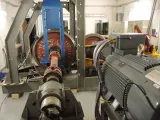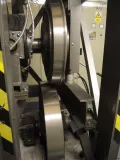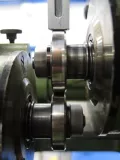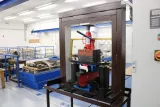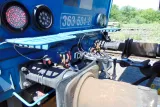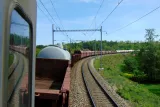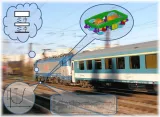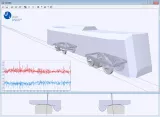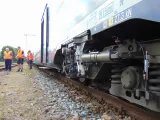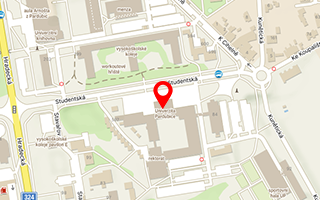The field of rail vehicles has been strong at the Faculty of Transport Engineering since the establishment of the faculty in 1993. In our research, we deal with topics essential for the efficiency and safety of rail transport. We use theoretical methods, experimental activities in laboratories as well as real vehicles in operation.
News
Updates on our research can be found in our Rail Vehicles Research Team LinkedIn profile.
Contact
Are you interested in opportunities for PhD study or research collaboration? Do not hesitate to let us know.
RESEARCH TOPICS
- Train dynamics – relevant to energy consumption in transport, train resistances, timetabling in rail transport (including the impact of ECTS braking curves), characteristics of draw and buffing gear etc.
- Vehicle–track interaction – adhesion phenomena, wheel–rail friction management, track-friendliness of rolling stock, wheel and rail wear, safety against derailment.
- Analysis of dynamical behaviour of rail vehicles – includes simulations and experiments to assess riding characteristics of rolling stock, running safety, track loading and potential benefits of advanced technologies (active elements, semi-active dampers, ...).
- Vehicle and infrastructure diagnostics – aiming at monitoring and assessment of technical condition based on dynamical response during running.
Head of the research team:
Members:
Jan Pulda
JENIŠ, F., MICHÁLEK, T., KUBÍK, M., STRECKER, Z., ŠLAPÁK, J., MAZŮREK, I. The influence of semi-actively controlled magnetorheological bogie yaw dampers on the guiding behaviour of a railway vehicle in an S-curve: Simulation and on-track test. In Proceedings of the Institution of Mechanical Engineers, Part F: Journal of Rail and Rapid Transit, Vol. 239, No. 1, (2025), p. 29–38. ISSN 0954-4097. DOI: 10.1177/09544097241282728.
JENIŠ, F., MICHÁLEK, T., KUBÍK, M., HÁBA, A., STRECKER, Z., ŽÁČEK, J., MAZŮREK, I. Semi-active yaw dampers in locomotive running gear: New control algorithms and verification of their stabilising effect. In Journal of Vibration and Control, 13.06.2024. ISSN 1077-5463. DOI: 10.1177/10775463241255765.
MICHÁLEK, T., KOHOUT, M., ŠLAPÁK, J., VÁGNER, J., PULDA, J. Curving and running resistance of freight trains: current experience with on-track measurements. In Vehicle System Dynamics, 29.08.2024. ISSN 0042-3114. DOI: 10.1080/00423114.2024.2398003.
VOLLEBREGT, E., VOLTR, P. Improved accuracy for FASTSIM using one or three flexibility values. In Vehicle System Dynamics, 2023, 61(1), p. 309–317. ISSN 0042-3114. DOI: 10.1080/00423114.2022.2042331.
ŠLAPÁK, J., MICHÁLEK, T. Comparison of selected parameters for evaluation of rail surface damage intensity. In Acta Polytechnica CTU Proceedings, 2022, 35(10.5.2022), p. 42–48. ISSN 2336-5382. DOI: 10.14311/APP.2022.35.0042.
MICHÁLEK, T., KOHOUT, M. On the problems of lateral force effects of railway vehicles in S-curves. In Vehicle System Dynamics, 2022, 60(8), p. 2739–2757. ISSN 0042-3114. DOI: 10.1080/00423114.2021.1917631.
ZIREK, A., VOLTR, P., LATA, M. Validation of an anti-slip control method based on the angular acceleration of a wheel on a roller rig. In Proceedings of the Institution of Mechanical Engineers, Part F: Journal of Rail and Rapid Transit, 2020, 232(10). ISSN 0954-4097. DOI: 10.1177/0954409719881085.
BUCKLEY-JOHNSTONE, L., TRUMMER, G., VOLTR, P., SIX, K., LEWIS, R. Full-scale testing of low adhesion effects with small amounts of water in the wheel/rail interface. In Tribology International, 2019, 141(16.8.2019). ISSN 0301-679X. DOI: 10.1016/j.triboint.2019.105907.
MICHÁLEK, T. Modification of train resistance formulae for container trains based on operational run-down tests. In Proceedings of the Institution of Mechanical Engineers, Part F: Journal of Rail and Rapid Transit, 2018, 232(6), p. 1588–1597. ISSN 0954-4097. DOI: 10.1177/0954409717738690.
KOVÁŘ, O., BUBEN, D., ROPEK, J., VÁGNER, J., KOHOUT, M. Device for monitoring the dynamic response of moving rail vehicles. Pilot plant, STARMON s.r.o., 2024, CK02000218-V1 (PDF document, in Czech)
VÁGNER, J., KOHOUT, M., HÁBA, A. Mobile device DISC-M for measuring and collecting data about turnouts. Functioning sample, University of Pardubice, 2023, CK0100091-V5 (PDF document, in Czech)
KOHOUT, M., ZELENKA, J. Wheel profile ZK-PL-0. Results projected into guidelines and other non-legislative regulations, Decision of the Railway Office DUCR-19975/20/Mp
KOREJTKO, J., HOŘÍNEK, M., STŘÍTESKÝ, V., KOHOUT, M. Telemetry unit for railway car. Functioning sample, DAKO-CZ, a.s., 2020, FV001/2020 (PDF document, in Czech)
ZELENKA, J., VÁGNER, J., HÁBA, A., KOHOUT, M. Diagnostics of metro running gear without dismounting. Methodology, 2018, 120/2018-710-VV/1 (PDF document, in Czech)
ZELENKA, J., VÁGNER, J., KOHOUT, M., HÁBA, A. Diagnostic system of fault detection of metro vehicles. Functioning sample, University of Pardubice, 2018, CKDV-FV-2018-JV-01
FIŠR, Z., MICHÁLEK, T. Program RailCalc 2.0. Software, University of Pardubice, 2021 (website, in Czech)
ZELENKA, J., MICHÁLEK, T., VOLTR, P. Multi-body simulation tool SJKV-V4N version 1.0. Software, University of Pardubice, 2018 (website, in Czech)
HAUPT, L., MICHÁLEK, T. A three-axle locomotive bogie. Utility model no. 31311, CZ LOKO, a.s., 2017 (PDF document, in Czech)
2025–2027: CL02000125 Advanced Diagnostics of Railway Turnout Movable Parts, Technology Agency of the Czech Republic, programme Doprava 2030
2024–2026: CL01000243 On board diagnostics of rail vehicle running gear, Technology Agency of the Czech Republic, programme Doprava 2030 (information in Starfos)
2023–2028: TN02000054 Božek Vehicle Engineering National Center of Competence, Technology Agency of the Czech Republic, programme National Centers of Competence (information in Starfos)
2023–2026: CK04000210 Semiactive damping system for single deck electric multiple unit, Technology Agency of the Czech Republic, programme Doprava 2020+ (information in Starfos)
2021–2023: CK02000218 Wayside diagnostic of railway vehicles running gear (DiPo), Technology Agency of the Czech Republic, programme Doprava 2020+ (information in Starfos)
2020–2024: CK01000091 Turnout 4.0, Technology Agency of the Czech Republic, programme Doprava 2020+ (information in Starfos)
2017–2018: I04 POB 15 The use of Dry-Ice Blasting to give Predictable and Optimised Braking Conditions; I04 POB 16 The use of Controlled Application of Water to the Wheel/Rail Interface to give Predictable and Optimised Braking Conditions; Rail Safety and Standards Board Ltd. (United Kingdom), programme Predictable and Optimized Braking
2016–2019: 730489 Switch and Crossing Optimal Design and Evaluation (S-CODE), European Union, programme Horizon 2020 (information in Cordis)
The members of the team are involved in teaching in the Bachelor’s and Master’s study programmes Transport Equipment at the Faculty of Transport Engineering (in Czech). Courses on theory and testing of rail vehicles particularly benefit from the research activities of the teachers. Our students can select thesis topics connected to railway research or join the team as assistants.
We have also launched the new Master’s study programme Rail Vehicles in the English language.
In relation to the activities of the research team, PhD topics are offered in the doctoral study programme Transport Means and Infrastructure.
ACTIVITIES
Experimental research of railway adhesion
The wheel–rail contact transmits not only the vertical load by the vehicle mass but also (almost) all other forces that influence vehicle movement, such as traction and braking forces. The ability of a locomotive to exert tractive effort depends on the motor power but also relies on adhesion, allowing to transform the rotation into the forward motion of the vehicle without wheel sliding. Current research is focused on the dependence of adhesion on various parameters. This has an impact on the development of calculation models, improvement of slip control algorithms and mitigation against low adhesion under adverse environmental conditions. The development aims at effective „friction management“ to control the wheel–rail contact conditions.
One of the principal tools for adhesion research is the tram wheel roller rig, located in the Educational and Research Centre in Transport. The roller rig contains a single PMSM-driven tram wheel, rolling against a roller representing the rail. The roller rig has been used for the following purposes:
- recording of traction characteristics in the presence of various contaminants;
- study of transient friction phenomena –wheel and rail conditioning during sliding (see paper)
- low adhesion conditions caused by small amounts of water together with iron oxides – collaboration on an international research project; the model WILAC (see paper) was developed based on these measurements
- possibilities of adhesion improvement by cleaning by water or dry ice – collaboration on international projects; dry-ice railhead cleaning is being tested in operation in Great Britain
- testing of slip control methods for powered rail vehicles (see e.g. paper)
We have upgraded the experimental equipment to enable measuring adhesion characteristics with solid lubricants and friction modifiers to extend the knowledge so far based only on small-scale twin-disc tests with limited possibilities of controlling the test conditions.
We also investigate the influence of spin on wheel–rail interaction with respect to safety against derailment. We aim to assess experimentally the influence of spin using a full-scale roller rig and check the results with rolling contact theory.
Research of train resistances
The train movement is accompanied by the action of resistance forces which generally act against the train movement and which must be overcome by the tractive effort of the powered vehicles. The physical nature of the train resistances is influenced by the design and technical condition of the vehicles (vehicle resistances) and infrastructure (track resistances – gradient, curves, tunnels). For the purpose of calculation of travel times and energy consumption, various empirical equations are used. These equations are based on research carried out in the 1980s and 1990s and may not correspond to today’s conditions. The difference is related to advances in railway technology, such as introduction of composite brake blocks, high quality axle bearing units, expansion of continuous welded rail technology, flexible rail fasteners, good track geometric quality, usage of multiple units in passenger transport etc.
In this context, our research team aims to improve the accuracy of train resistance equations using field experiments. This can be achieved by evaluation of vehicle run-down tests, but we also carry out measurement of locomotive tractive effort by an instrumented coupling with strain gauges, which can be fitted to any vehicle using the standard European screw coupling. In 2022 and 2023, we undertook the task announced by Správa železnic (the Czech railway infrastructure manager) consisting in updating the train resistance formulae.
We are also interested in analyses of the influence of curves and tunnels on train resistances. Experimental methods are complemented with numerical simulations. This makes a good topic for students‘ theses.
Computer simulations of rail vehicle dynamics
Today, computer simulations are an integral part of the development of new rail vehicles, allowing to optimise the vehicle design and examine its dynamical behaviour even before the prototype is built. Numerical simulations can also be employed to investigate the causes of excessive wear, damage or transport accidents. In addition to commercial software, the team uses an in-house simulation system „SJKV“ which has been continuously developed and improved at the Faculty of Transport Engineering. This system is based on multi-body simulation of rail vehicle movement and it has been utilized in the following tasks:
- development of the diesel locomotive series 744.0 by CZ LOKO,
- development of a new method to assess derailment safety of rail vehicles,
- development of a new three-axle locomotive bogie CZ LOKO for 1520mm track gauge,
- acceptance of the modernized C30-M locomotives for operation in Finland,
- optimization of suspension and mounting of the wheelset drive of an electric locomotive,
- assessment of tilting train effects on the track.
Numerical simulations also enable to test possible benefits of new technologies in terms of running safety, track-friendliness or passenger comfort. We take part in projects focused on assessment of the benefits of active wheelset steering in curves or semiactive controlled hydraulic dampers in vehicle suspension systems.
In the field of semi-actively controlled dampers for railway vehicles, we cooperate with colleagues from Brno University of Technology and Strojírna Oslavany on the development of control algorithms for fast magnetorheological dampers. In cooperation with VÚKV Praha, VZÚ in Plzeň and Czech Railways, the semi-active damping system for secondary suspension was tested in 2024 on the 10Ev EMU (InterPanter) in operation on the railway lines around Brno. The expected benefits of the new system, predicted using multi-body simulations, were thus experimentally verified on a real vehicle.
Simulations are complemented by experiments to find the characteristics of suspension components (flexi-coil springs, hydraulic dampers, draw and buffing gear...) using the dynamic test lab of the Faculty of Transport Engineering. In this way, the characteristics of real components can be obtained for simulations.

